Jiaqi Wang
Michael Pokorny
Spatial-SSRL: Enhancing Spatial Understanding via Self-Supervised Reinforcement Learning
Oct 31, 2025Abstract:Spatial understanding remains a weakness of Large Vision-Language Models (LVLMs). Existing supervised fine-tuning (SFT) and recent reinforcement learning with verifiable rewards (RLVR) pipelines depend on costly supervision, specialized tools, or constrained environments that limit scale. We introduce Spatial-SSRL, a self-supervised RL paradigm that derives verifiable signals directly from ordinary RGB or RGB-D images. Spatial-SSRL automatically formulates five pretext tasks that capture 2D and 3D spatial structure: shuffled patch reordering, flipped patch recognition, cropped patch inpainting, regional depth ordering, and relative 3D position prediction. These tasks provide ground-truth answers that are easy to verify and require no human or LVLM annotation. Training on our tasks substantially improves spatial reasoning while preserving general visual capabilities. On seven spatial understanding benchmarks in both image and video settings, Spatial-SSRL delivers average accuracy gains of 4.63% (3B) and 3.89% (7B) over the Qwen2.5-VL baselines. Our results show that simple, intrinsic supervision enables RLVR at scale and provides a practical route to stronger spatial intelligence in LVLMs.
Whole-Body Proprioceptive Morphing: A Modular Soft Gripper for Robust Cross-Scale Grasping
Oct 31, 2025Abstract:Biological systems, such as the octopus, exhibit masterful cross-scale manipulation by adaptively reconfiguring their entire form, a capability that remains elusive in robotics. Conventional soft grippers, while compliant, are mostly constrained by a fixed global morphology, and prior shape-morphing efforts have been largely confined to localized deformations, failing to replicate this biological dexterity. Inspired by this natural exemplar, we introduce the paradigm of collaborative, whole-body proprioceptive morphing, realized in a modular soft gripper architecture. Our design is a distributed network of modular self-sensing pneumatic actuators that enables the gripper to intelligently reconfigure its entire topology, achieving multiple morphing states that are controllable to form diverse polygonal shapes. By integrating rich proprioceptive feedback from embedded sensors, our system can seamlessly transition from a precise pinch to a large envelope grasp. We experimentally demonstrate that this approach expands the grasping envelope and enhances generalization across diverse object geometries (standard and irregular) and scales (up to 10$\times$), while also unlocking novel manipulation modalities such as multi-object and internal hook grasping. This work presents a low-cost, easy-to-fabricate, and scalable framework that fuses distributed actuation with integrated sensing, offering a new pathway toward achieving biological levels of dexterity in robotic manipulation.
CRAG-MM: Multi-modal Multi-turn Comprehensive RAG Benchmark
Oct 30, 2025Abstract:Wearable devices such as smart glasses are transforming the way people interact with their surroundings, enabling users to seek information regarding entities in their view. Multi-Modal Retrieval-Augmented Generation (MM-RAG) plays a key role in supporting such questions, yet there is still no comprehensive benchmark for this task, especially regarding wearables scenarios. To fill this gap, we present CRAG-MM -- a Comprehensive RAG benchmark for Multi-modal Multi-turn conversations. CRAG-MM contains a diverse set of 6.5K (image, question, answer) triplets and 2K visual-based multi-turn conversations across 13 domains, including 6.2K egocentric images designed to mimic captures from wearable devices. We carefully constructed the questions to reflect real-world scenarios and challenges, including five types of image-quality issues, six question types, varying entity popularity, differing information dynamism, and different conversation turns. We design three tasks: single-source augmentation, multi-source augmentation, and multi-turn conversations -- each paired with an associated retrieval corpus and APIs for both image-KG retrieval and webpage retrieval. Our evaluation shows that straightforward RAG approaches achieve only 32% and 43% truthfulness on CRAG-MM single- and multi-turn QA, respectively, whereas state-of-the-art industry solutions have similar quality (32%/45%), underscoring ample room for improvement. The benchmark has hosted KDD Cup 2025, attracting about 1K participants and 5K submissions, with winning solutions improving baseline performance by 28%, highlighting its early impact on advancing the field.
The Universal Landscape of Human Reasoning
Oct 24, 2025Abstract:Understanding how information is dynamically accumulated and transformed in human reasoning has long challenged cognitive psychology, philosophy, and artificial intelligence. Existing accounts, from classical logic to probabilistic models, illuminate aspects of output or individual modelling, but do not offer a unified, quantitative description of general human reasoning dynamics. To solve this, we introduce Information Flow Tracking (IF-Track), that uses large language models (LLMs) as probabilistic encoder to quantify information entropy and gain at each reasoning step. Through fine-grained analyses across diverse tasks, our method is the first successfully models the universal landscape of human reasoning behaviors within a single metric space. We show that IF-Track captures essential reasoning features, identifies systematic error patterns, and characterizes individual differences. Applied to discussion of advanced psychological theory, we first reconcile single- versus dual-process theories in IF-Track and discover the alignment of artificial and human cognition and how LLMs reshaping human reasoning process. This approach establishes a quantitative bridge between theory and measurement, offering mechanistic insights into the architecture of reasoning.
$\text{G}^2$RPO: Granular GRPO for Precise Reward in Flow Models
Oct 02, 2025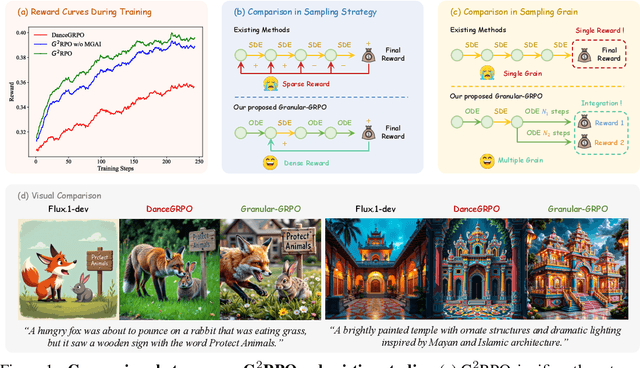
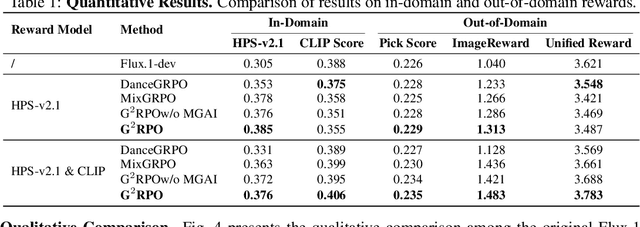
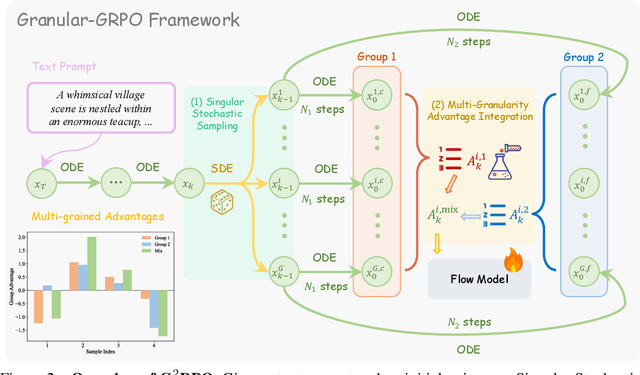

Abstract:The integration of online reinforcement learning (RL) into diffusion and flow models has recently emerged as a promising approach for aligning generative models with human preferences. Stochastic sampling via Stochastic Differential Equations (SDE) is employed during the denoising process to generate diverse denoising directions for RL exploration. While existing methods effectively explore potential high-value samples, they suffer from sub-optimal preference alignment due to sparse and narrow reward signals. To address these challenges, we propose a novel Granular-GRPO ($\text{G}^2$RPO ) framework that achieves precise and comprehensive reward assessments of sampling directions in reinforcement learning of flow models. Specifically, a Singular Stochastic Sampling strategy is introduced to support step-wise stochastic exploration while enforcing a high correlation between the reward and the injected noise, thereby facilitating a faithful reward for each SDE perturbation. Concurrently, to eliminate the bias inherent in fixed-granularity denoising, we introduce a Multi-Granularity Advantage Integration module that aggregates advantages computed at multiple diffusion scales, producing a more comprehensive and robust evaluation of the sampling directions. Experiments conducted on various reward models, including both in-domain and out-of-domain evaluations, demonstrate that our $\text{G}^2$RPO significantly outperforms existing flow-based GRPO baselines,highlighting its effectiveness and robustness.
CapRL: Stimulating Dense Image Caption Capabilities via Reinforcement Learning
Sep 26, 2025Abstract:Image captioning is a fundamental task that bridges the visual and linguistic domains, playing a critical role in pre-training Large Vision-Language Models (LVLMs). Current state-of-the-art captioning models are typically trained with Supervised Fine-Tuning (SFT), a paradigm that relies on expensive, non-scalable data annotated by humans or proprietary models. This approach often leads to models that memorize specific ground-truth answers, limiting their generality and ability to generate diverse, creative descriptions. To overcome the limitation of SFT, we propose applying the Reinforcement Learning with Verifiable Rewards (RLVR) paradigm to the open-ended task of image captioning. A primary challenge, however, is designing an objective reward function for the inherently subjective nature of what constitutes a "good" caption. We introduce Captioning Reinforcement Learning (CapRL), a novel training framework that redefines caption quality through its utility: a high-quality caption should enable a non-visual language model to accurately answer questions about the corresponding image. CapRL employs a decoupled two-stage pipeline where an LVLM generates a caption, and the objective reward is derived from the accuracy of a separate, vision-free LLM answering Multiple-Choice Questions based solely on that caption. As the first study to apply RLVR to the subjective image captioning task, we demonstrate that CapRL significantly enhances multiple settings. Pretraining on the CapRL-5M caption dataset annotated by CapRL-3B results in substantial gains across 12 benchmarks. Moreover, within the Prism Framework for caption quality evaluation, CapRL achieves performance comparable to Qwen2.5-VL-72B, while exceeding the baseline by an average margin of 8.4%. Code is available here: https://github.com/InternLM/CapRL.
MinerU2.5: A Decoupled Vision-Language Model for Efficient High-Resolution Document Parsing
Sep 26, 2025Abstract:We introduce MinerU2.5, a 1.2B-parameter document parsing vision-language model that achieves state-of-the-art recognition accuracy while maintaining exceptional computational efficiency. Our approach employs a coarse-to-fine, two-stage parsing strategy that decouples global layout analysis from local content recognition. In the first stage, the model performs efficient layout analysis on downsampled images to identify structural elements, circumventing the computational overhead of processing high-resolution inputs. In the second stage, guided by the global layout, it performs targeted content recognition on native-resolution crops extracted from the original image, preserving fine-grained details in dense text, complex formulas, and tables. To support this strategy, we developed a comprehensive data engine that generates diverse, large-scale training corpora for both pretraining and fine-tuning. Ultimately, MinerU2.5 demonstrates strong document parsing ability, achieving state-of-the-art performance on multiple benchmarks, surpassing both general-purpose and domain-specific models across various recognition tasks, while maintaining significantly lower computational overhead.
SPARK: Synergistic Policy And Reward Co-Evolving Framework
Sep 26, 2025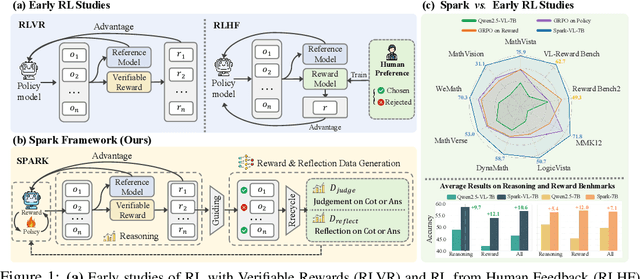
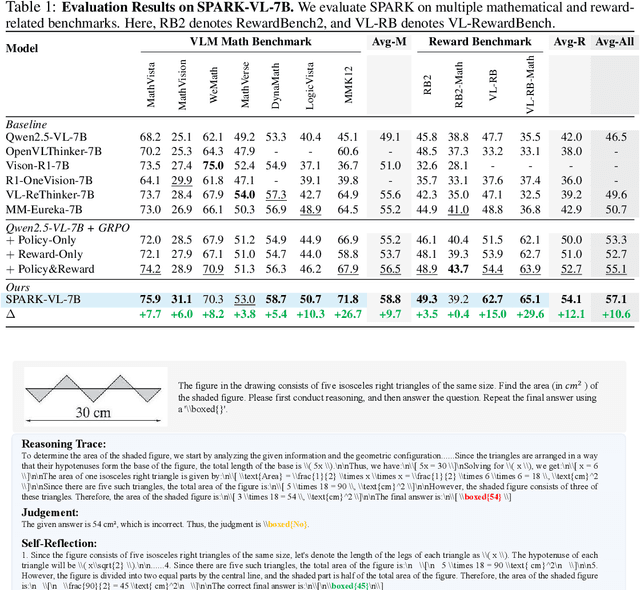
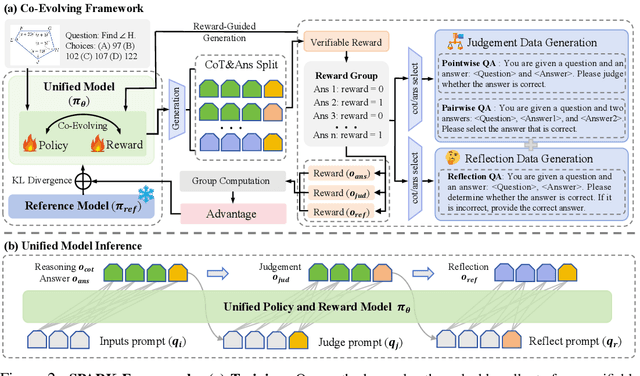
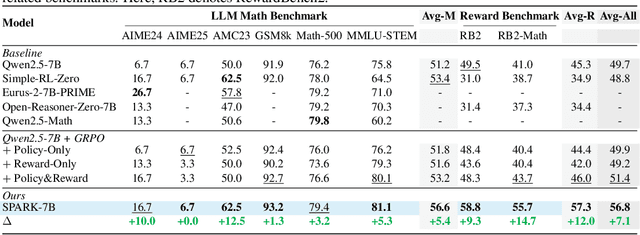
Abstract:Recent Large Language Models (LLMs) and Large Vision-Language Models (LVLMs) increasingly use Reinforcement Learning (RL) for post-pretraining, such as RL with Verifiable Rewards (RLVR) for objective tasks and RL from Human Feedback (RLHF) for subjective tasks. However, RLHF incurs high costs and potential reward-policy mismatch due to reliance on human preferences, while RLVR still wastes supervision by discarding rollouts and correctness signals after each update. To address these challenges, we introduce the Synergistic Policy And Reward Co-Evolving Framework (SPARK), an efficient, on-policy, and stable method that builds on RLVR. Instead of discarding rollouts and correctness data, SPARK recycles this valuable information to simultaneously train the model itself as a generative reward model. This auxiliary training uses a mix of objectives, such as pointwise reward score, pairwise comparison, and evaluation conditioned on further-reflection responses, to teach the model to evaluate and improve its own responses. Our process eliminates the need for a separate reward model and costly human preference data. SPARK creates a positive co-evolving feedback loop: improved reward accuracy yields better policy gradients, which in turn produce higher-quality rollouts that further refine the reward model. Our unified framework supports test-time scaling via self-reflection without external reward models and their associated costs. We show that SPARK achieves significant performance gains on multiple LLM and LVLM models and multiple reasoning, reward models, and general benchmarks. For example, SPARK-VL-7B achieves an average 9.7% gain on 7 reasoning benchmarks, 12.1% on 2 reward benchmarks, and 1.5% on 8 general benchmarks over the baselines, demonstrating robustness and broad generalization.
ConvergeWriter: Data-Driven Bottom-Up Article Construction
Sep 16, 2025Abstract:Large Language Models (LLMs) have shown remarkable prowess in text generation, yet producing long-form, factual documents grounded in extensive external knowledge bases remains a significant challenge. Existing "top-down" methods, which first generate a hypothesis or outline and then retrieve evidence, often suffer from a disconnect between the model's plan and the available knowledge, leading to content fragmentation and factual inaccuracies. To address these limitations, we propose a novel "bottom-up," data-driven framework that inverts the conventional generation pipeline. Our approach is predicated on a "Retrieval-First for Knowledge, Clustering for Structure" strategy, which first establishes the "knowledge boundaries" of the source corpus before any generative planning occurs. Specifically, we perform exhaustive iterative retrieval from the knowledge base and then employ an unsupervised clustering algorithm to organize the retrieved documents into distinct "knowledge clusters." These clusters form an objective, data-driven foundation that directly guides the subsequent generation of a hierarchical outline and the final document content. This bottom-up process ensures that the generated text is strictly constrained by and fully traceable to the source material, proactively adapting to the finite scope of the knowledge base and fundamentally mitigating the risk of hallucination. Experimental results on both 14B and 32B parameter models demonstrate that our method achieves performance comparable to or exceeding state-of-the-art baselines, and is expected to demonstrate unique advantages in knowledge-constrained scenarios that demand high fidelity and structural coherence. Our work presents an effective paradigm for generating reliable, structured, long-form documents, paving the way for more robust LLM applications in high-stakes, knowledge-intensive domains.
LTA-thinker: Latent Thought-Augmented Training Framework for Large Language Models on Complex Reasoning
Sep 16, 2025Abstract:Complex Reasoning in Large Language Models can be dynamically optimized using Test-Time Scaling (TTS) to mitigate Overthinking. Methods such as Coconut, SoftCoT and its variant are effective in continuous latent space inference, the core bottleneck still lies in the efficient generation and utilization of high-quality Latent Thought. Drawing from the theory of SoftCoT++ that a larger variance in the generated Latent Thought distribution more closely approximates the golden truth distribution, we propose a Latent Thought-Augmented Training Framework--LTA-Thinker, which improves distributional variance and enhances reasoning performance from two perspectives. First, LTA-Thinker constructs a Latent Thought generation architecture based on a learnable prior. This architecture aims to increase the variance distribution of generated Latent Thought Vectors in order to simplify the overall structure and raise the performance ceiling. Second, LTA-Thinker introduces a distribution-based directional optimization paradigm that jointly constrains both distribution locality and distribution scale. This mechanism improves information efficiency and computational cost through a multi-objective co-training strategy, which combines standard Supervised Fine-Tuning (SFT) loss with two novel losses: Semantic Alignment Loss, which utilizes KL divergence to ensure that the Latent Thought is highly relevant to the semantics of the question; Reasoning Focus Loss, which utilizes a contrastive learning mechanism to guide the model to focus on the most critical reasoning steps. Experiments show that LTA-thinker achieves state-of-the-art (SOTA) performance among various baselines and demonstrates a higher performance ceiling and better scaling effects.
 Add to Chrome
Add to Chrome Add to Firefox
Add to Firefox Add to Edge
Add to Edge